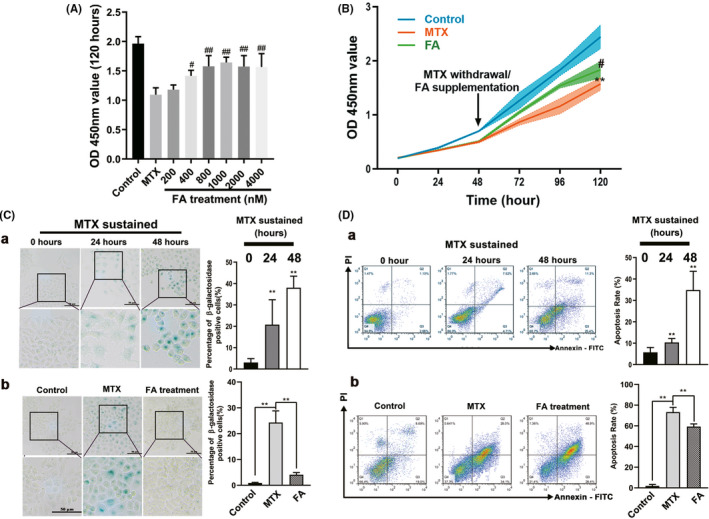FIGURE 3.

Methotrexate (MTX) caused the senescence and the apoptosis of human granulosa cells (GCs; KGN cells), which can be released by folic acid (FA) antagonism. (A) Forty‐eight hours after continuous treatment with 50 nM MTX, KGN cells were replaced with different concentrations of FA and cultured in FA‐containing medium for 72 h. The activity of KGN cells was determined. It was found that 1000 nM FA had the best recovery ability to KGN cells activity. (B) Detection of KGN cells proliferation in the MTX, FA treatment, and control group using cell counting kit‐8 (CCK‐8) assay. KGN cells proliferation was inhibited at 48 h after MTX administration and the effect was sustained till 72 h after MTX withdrawal. The proliferation of KGN cells was partially restored with the addition of FA. (C) (a) Senescent KGN cells appeared at 48 h after MTX sustained treatment accompanied by morphological changes and mainly defined as β‐ galactosidase positive cells. (b) Senescent KGN cells could still be observed at 72 h after MTX withdrawal. Senescent KGN cells no longer appeared 72 h after FA was added. (D) (a) Apoptosis of KGN cells induced by MTX appeared in large numbers at 48 h after MTX treatment. (b) Seventy‐two hours after MTX withdrawal, KGN cells still appeared in the early apoptosis stage. The apoptosis of KGN cells could be significantly reduced by the addition of FA after MTX withdrawal. (Symbol * indicates a difference between MTX processed group and control group, **p < 0.01; Symbol # indicates a difference between MTX and FA treatment groups, # p < 0.05, ## p < 0.01. Student’s t‐test; Scale bars: 50 μm)
